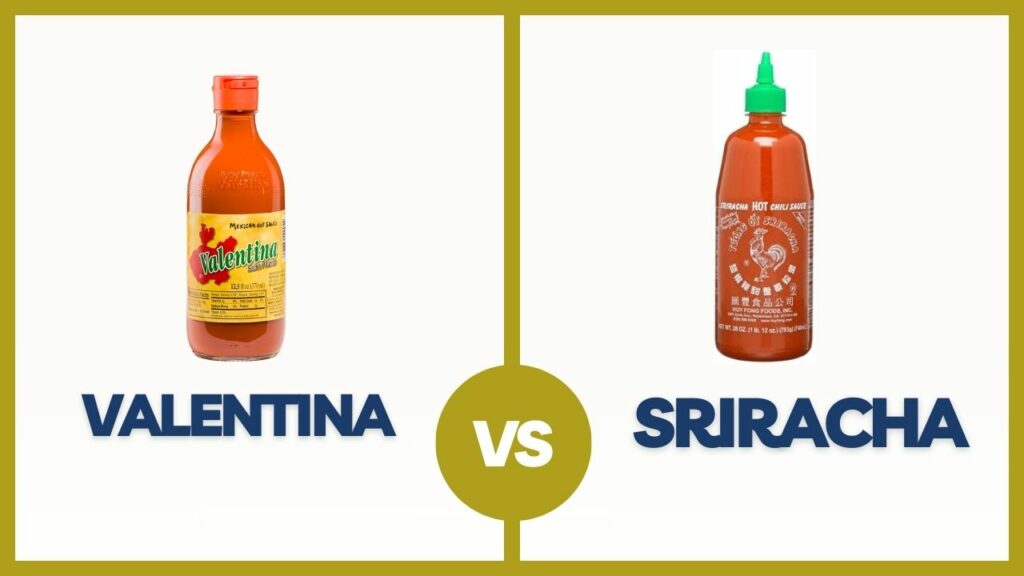Hot sauces add a spicy kick and depth to many dishes and are beloved by food enthusiasts worldwide.
Among the plethora of hot sauce brands, Sriracha and Valentina stand out for their distinct flavors and cult followings.
This article takes a detailed look at both Sriracha and Valentina, comparing their history, ingredients, taste, heat levels, usage in cooking, bottle sizes, prices, and dietary specifications.

What Is It, Who Founded It, And Where Is The Headquarters Based: Sriracha vs Valentina
Sriracha is a type of hot sauce named after the coastal city of Si Racha in Thailand. It was popularized in the United States by a Vietnamese immigrant named David Tran, who founded Huy Fong Foods in 1980.
The company’s headquarters and manufacturing plant are based in Irwindale, California.
Sriracha is made from sun-ripened chilies which are ground into a smooth paste along with garlic and packaged in a convenient squeeze bottle.
It is often referred to as “rooster sauce” because of the rooster logo on its bottles — an homage to the year of the Rooster when Tran was born.
On the other hand, Valentina is a brand of “pourable” hot sauce manufactured by Salsa Tamazula, a company based in Guadalajara, Mexico.
This traditional Mexican hot sauce is made with puya chilis from Jalisco state, which are similar to the Guajillo chili and also known as guajillo puya.
The factory for Valentina hot sauce is located in Guadalajara and spans over an impressive 279,000 square feet.
Despite its roots and vast footprint in Mexico where it’s widely distributed, Valentina has expanded its reach to families all over North America and other countries via their international sales office.
What Does It Contain: Sriracha vs Valentina
Sriracha and Valentina both are renowned for their unique flavors, which come from their distinct set of ingredients.
Sriracha’s signature taste is crafted from a base of red chili peppers, sugar, salt, garlic, distilled vinegar, potassium sorbate, sodium bisulfite as preservatives, and xanthan gum.
The result is a tangy sauce with sweet undertones and a bold garlic presence.
On the other hand, Valentina hot sauce contains a simpler list of ingredients that lend it a more traditional Mexican flavor profile.
It’s made with water, chili peppers, vinegar, salt, spices and a small amount of Sodium Benzoate as a preservative (0.1%).
This blend creates a sauce that is less vinegary than most hot sauces on the market and has an emphasis on rich chili flavor over outright heat.
How Many Varieties Of Hot Sauces Does Valentina Offer?
Valentina currently offers three varieties of “Valentina” hot sauce, each with a distinct heat level and flavor profile.
The Red Label variety is the original recipe, which provides a medium heat level and a classic, well-rounded chili flavor. It’s a versatile condiment ideal for a wide range of dishes.
The Black Label, or “Extra Hot,” version is designed for those who prefer a more intense spice. It maintains the rich chili flavor but amps up the heat for a more fiery experience.
The Blue Label is the Valentina MARISQUERA offered in a 8.4 fl oz bottle. It is a seafood version of the original sauce.
Which Taste Better: Sriracha vs Valentina
The question of which hot sauce tastes better — Sriracha or Valentina — comes down to personal preference as each offers a unique flavor profile.
Sriracha is known for its sweet and garlicky flavor with a tangy twist, thanks to the addition of vinegar.
The sun-ripened chilies give it a distinctive taste that has made it popular in a variety of dishes, especially Asian cuisines.
If you enjoy a sweet heat with a garlic punch, Sriracha might be more to your liking.
On the other hand, Valentina is praised for its authentic Mexican flavor that is citrusy with a spicy aftertaste.
It is less vinegary and sweeter than most hot sauces on the market providing an earthy chilli flavor.
If you prefer a less acidic and more balanced flavor reminiscent of traditional Mexican cuisine, you might find Valentina more appealing.
Which Is Spicier: Sriracha vs Valentina
Again, the spiciness of Sriracha and Valentina may vary depending on personal tolerance and preference for heat. However, when comparing them side by side, some points can be made.
Sriracha, with its red jalapeno base, has a moderate heat level that provides a nice kick without being overwhelming. On the Scoville scale (a measure of spiciness), Sriracha measures around 2,200 units.
Valentina’s heat level can vary depending upon the version you choose. The red label offers medium heat while the black label (“Extra Hot”) delivers intensified spiciness.
However, even at its hottest, Valentina is usually considered less spicy than Sriracha. This is because Valentina focuses more on delivering a robust flavor rather than intense heat.
In terms of pure “spiciness,” Sriracha would likely rank higher. But those who prefer a balanced blend of heat and rich flavor may gravitate towards Valentina hot sauce instead.
Can I Use Valentina Instead Of Sriracha? (And Vice Versa)
Yes, you can definitely use Valentina instead of Sriracha and vice versa, depending on your culinary needs and flavor preferences.
However, do keep in mind that both of these sauces come with distinct flavor profiles that will impact the overall taste of your dish.
Sriracha has a sweet garlicky heat which is great for adding a tangy zing to noodle dishes, stir-fries, soups, and marinades. It is often favored in Thai and Vietnamese cuisine.
On the other hand, Valentina boasts a traditional Mexican flavor that is citrusy with less vinegar and more earthy chili notes. It’s excellent for enhancing the flavors in tacos, burritos, grilled meats or any dish where its unique taste can shine.
While both sauces can offer your dishes a spicy boost, they will impart different flavors. So feel free to experiment and see how each sauce enhances your culinary creations differently!
What Are The Different Size Options: Sriracha vs Valentina
Both Sriracha and Valentina come in several size options to cater to varying consumer needs.
For Sriracha, the most commonly seen size is the iconic 17-ounce (482 grams) bottle with a green cap. However, smaller 9-ounce (255 grams) bottles are also available. For catering or heavy-duty use, there are also larger sizes – up to 8.5 pounds (3.86 kg).
Valentina, on the other hand, offers an even wider array of sizes. Small 5 fl oz bottles are perfect for those who want to try the sauce or need something portable.
The standard sizes of 12.5 fl oz and 34 fl oz cater well to regular home usage.
For commercial purposes or serious hot sauce aficionados, Valentina also offers a hefty 1.1-gallon bottle. Plus, convenient 10ml packets are available for on-the-go spice needs.
These various size options make both Sriracha and Valentina adaptable to different usage habits – whether you’re a casual user or a hot sauce enthusiast.
Which Is More Cost Effective: Sriracha vs Valentina
When it comes to cost-effectiveness, Valentina tends to be more affordable than Sriracha.
A 12 fl oz bottle of Valentina hot sauce typically costs between $1 to $2, depending on the store and region. This makes it incredibly budget-friendly for its quality and flavor.
On the other hand, a 17-ounce bottle of Sriracha usually ranges between $3 to $5. While still reasonable, Sriracha is notably more expensive than Valentina.
Of course, prices can vary based on location, packaging size, and where you buy from. However, in general terms, if you’re looking for a wallet-friendly option that delivers on taste and heat, Valentina may be the more cost-effective choice.
Is It Gluten Free, Halal, Vegan and Whole 360: Sriracha vs Valentina
When it comes to dietary restrictions or lifestyle choices, the suitability of Sriracha and Valentina can vary.
Sriracha sauce from Huy Fong does not have a gluten-free certification. While its ingredients don’t inherently contain gluten, cross contamination during production cannot be ruled out.
Regarding being Halal and vegan, Huy Fong’s Sriracha also doesn’t carry these certifications. The sugar used in their Sriracha sauce is refined using bone char, a substance made by charring animal bones.
This process makes the sugar non-vegan as it involves animal exploitation. Therefore, if you’re following a strict vegan diet, Huy Fong’s Sriracha might not fit your preferences.
On the other hand, Valentina hot sauce is generally considered to be gluten-free based on its ingredient list, even though it does not have a “halal” certification. However, it’s always best to check with the manufacturer for cross-contamination possibilities if you are extremely sensitive to gluten.
As for Valentina being suitable for a vegan or vegetarian diet, most food experts agree that it is safe as none of its listed ingredients come from animal sources.
However, it should be noted that Valentina does not carry any official vegan certification. Therefore individuals following strict diets should contact the company directly to confirm.
Neither of these sauces carries an official Whole 360 certification at this time.

